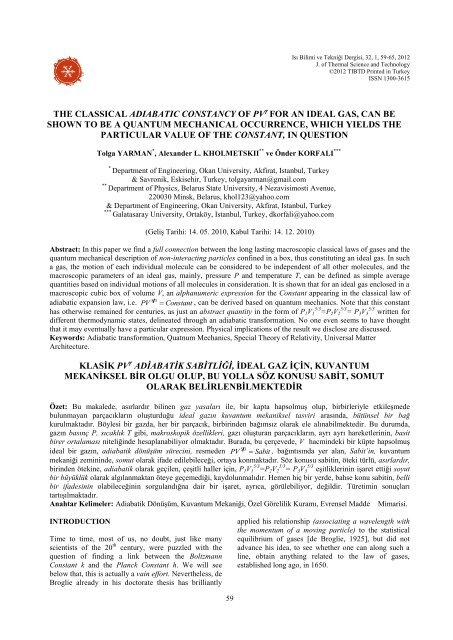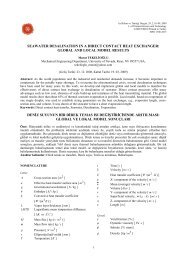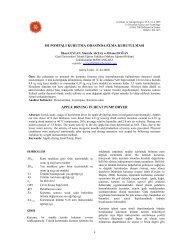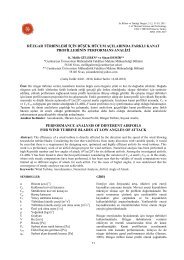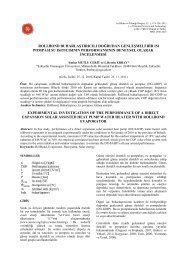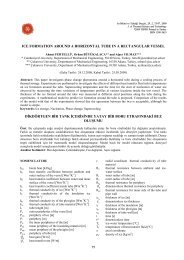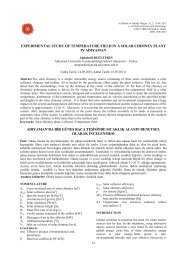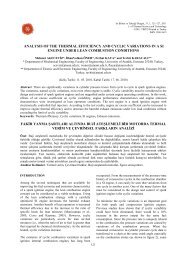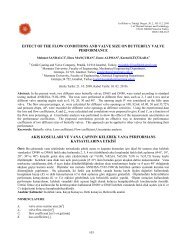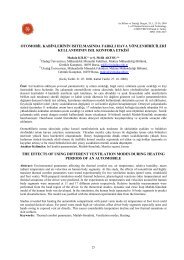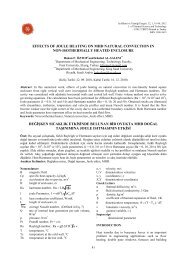the constancy of for an ideal gas undergoing an adiabatic ...
the constancy of for an ideal gas undergoing an adiabatic ...
the constancy of for an ideal gas undergoing an adiabatic ...
Create successful ePaper yourself
Turn your PDF publications into a flip-book with our unique Google optimized e-Paper software.
Isı Bilimi ve Tekniği Dergisi, 32, 1, 59-65, 2012<br />
J. <strong>of</strong> Thermal Science <strong>an</strong>d Technology<br />
©2012 TIBTD Printed in Turkey<br />
ISSN 1300-3615<br />
THE CLASSICAL ADIABATIC CONSTANCY OF PV FOR AN IDEAL GAS, CAN BE<br />
SHOWN TO BE A QUANTUM MECHANICAL OCCURRENCE, WHICH YIELDS THE<br />
PARTICULAR VALUE OF THE CONSTANT, IN QUESTION<br />
Tolga YARMAN * , Alex<strong>an</strong>der L. KHOLMETSKII ** ve Önder KORFALI ***<br />
*<br />
Department <strong>of</strong> Engineering, Ok<strong>an</strong> University, Akfirat, Ist<strong>an</strong>bul, Turkey<br />
& Savronik, Eskisehir, Turkey, tolgayarm<strong>an</strong>@gmail.com<br />
**<br />
Department <strong>of</strong> Physics, Belarus State University, 4 Nezavisimosti Avenue,<br />
220030 Minsk, Belarus, khol123@yahoo.com<br />
& Department <strong>of</strong> Engineering, Ok<strong>an</strong> University, Akfirat, Ist<strong>an</strong>bul, Turkey<br />
***<br />
Galatasaray University, Ortaköy, Ist<strong>an</strong>bul, Turkey, dkorfali@yahoo.com<br />
(Geliş Tarihi: 14. 05. 2010, Kabul Tarihi: 14. 12. 2010)<br />
Abstract: In this paper we find a full connection between <strong>the</strong> long lasting macroscopic classical laws <strong>of</strong> <strong>gas</strong>es <strong>an</strong>d <strong>the</strong><br />
qu<strong>an</strong>tum mech<strong>an</strong>ical description <strong>of</strong> non-interacting particles confined in a box, thus constituting <strong>an</strong> <strong>ideal</strong> <strong>gas</strong>. In such<br />
a <strong>gas</strong>, <strong>the</strong> motion <strong>of</strong> each individual molecule c<strong>an</strong> be considered to be independent <strong>of</strong> all o<strong>the</strong>r molecules, <strong>an</strong>d <strong>the</strong><br />
macroscopic parameters <strong>of</strong> <strong>an</strong> <strong>ideal</strong> <strong>gas</strong>, mainly, pressure P <strong>an</strong>d temperature T, c<strong>an</strong> be defined as simple average<br />
qu<strong>an</strong>tities based on individual motions <strong>of</strong> all molecules in consideration. It is shown that <strong>for</strong> <strong>an</strong> <strong>ideal</strong> <strong>gas</strong> enclosed in a<br />
macroscopic cubic box <strong>of</strong> volume V, <strong>an</strong> alph<strong>an</strong>umeric expression <strong>for</strong> <strong>the</strong> Const<strong>an</strong>t appearing in <strong>the</strong> classical law <strong>of</strong><br />
5 3<br />
<strong>adiabatic</strong> exp<strong>an</strong>sion law, i.e. PV Const<strong>an</strong>t , c<strong>an</strong> be derived based on qu<strong>an</strong>tum mech<strong>an</strong>ics. Note that this const<strong>an</strong>t<br />
has o<strong>the</strong>rwise remained <strong>for</strong> centuries, as just <strong>an</strong> abstract qu<strong>an</strong>tity in <strong>the</strong> <strong>for</strong>m <strong>of</strong> P 1 V 5/3 1 =P 2 V 5/3 2 = P 3 V 5/3 3 written <strong>for</strong><br />
different <strong>the</strong>rmodynamic states, delineated through <strong>an</strong> <strong>adiabatic</strong> tr<strong>an</strong>s<strong>for</strong>mation. No one even seems to have thought<br />
that it may eventually have a particular expression. Physical implications <strong>of</strong> <strong>the</strong> result we disclose are discussed.<br />
Keywords: Adiabatic tr<strong>an</strong>s<strong>for</strong>mation, Quatnum Mech<strong>an</strong>ics, Special Theory <strong>of</strong> Relativity, Universal Matter<br />
Architecture.<br />
KLASİK PV ADİABATİK SABİTLİĞİ, İDEAL GAZ İÇİN, KUVANTUM<br />
MEKANİKSEL BİR OLGU OLUP, BU YOLLA SÖZ KONUSU SABİT, SOMUT<br />
OLARAK BELİRLENBİLMEKTEDİR<br />
Özet: Bu makalede, asırlardır bilinen gaz yasaları ile, bir kapta hapsolmuş olup, birbirleriyle etkileşmede<br />
bulunmay<strong>an</strong> parçacıkların oluşturduğu <strong>ideal</strong> gazın kuv<strong>an</strong>tum mek<strong>an</strong>iksel tasviri arasında, bütünsel bir bağ<br />
kurulmaktadır. Böylesi bir gazda, her bir parçacık, birbirinden bağımsız olarak ele alınabilmektedir. Bu durumda,<br />
gazın basınç P, sıcaklık T gibi, makroskopik özellikleri, gazı oluştur<strong>an</strong> parçacıkların, ayrı ayrı hareketlerinin, basit<br />
birer ortalaması niteliğinde hesapl<strong>an</strong>abiliyor olmaktadır. Burada, bu çerçevede, V hacmindeki bir küpte hapsolmuş<br />
5 3<br />
<strong>ideal</strong> bir gazın, adiabatik dönüşüm sürecini, resmeden PV Sabit , bağıntısında yer al<strong>an</strong>, Sabit’in, kuv<strong>an</strong>tum<br />
mek<strong>an</strong>iği zemininde, somut olarak ifade edilebileceği, ortaya konmaktadır. Söz konusu sabitin, öteki türlü, asırlardır,<br />
birinden ötekine, adiabatik olarak geçilen, çeşitli haller için, P 1 V 5/3 1 =P 2 V 5/3 2 = P 3 V 5/3 3 eşitliklerinin işaret ettiği soyut<br />
bir büyüklük olarak algıl<strong>an</strong>makt<strong>an</strong> öteye geçemediği, kaydolunmalıdır. Hemen hiç bir yerde, bahse konu sabitin, belli<br />
bir ifadesinin olabileceğinin sorgul<strong>an</strong>dığna dair bir işaret, ayrıca, görülebiliyor, değildir. Türetimin sonuçları<br />
tartışılmaktadır.<br />
Anahtar Kelimeler: Adiabatik Dönüşüm, Kuv<strong>an</strong>tum Mek<strong>an</strong>iği, Özel Görelilik Kuramı, Evrensel Madde<br />
Mimarisi.<br />
INTRODUCTION<br />
Time to time, most <strong>of</strong> us, no doubt, just like m<strong>an</strong>y<br />
scientists <strong>of</strong> <strong>the</strong> 20 th century, were puzzled with <strong>the</strong><br />
question <strong>of</strong> finding a link between <strong>the</strong> Boltzm<strong>an</strong>n<br />
Const<strong>an</strong>t k <strong>an</strong>d <strong>the</strong> Pl<strong>an</strong>ck Const<strong>an</strong>t h. We will see<br />
below that, this is actually a vain ef<strong>for</strong>t. Never<strong>the</strong>less, de<br />
Broglie already in his doctorate <strong>the</strong>sis has brilli<strong>an</strong>tly<br />
applied his relationship (associating a wavelength with<br />
<strong>the</strong> momentum <strong>of</strong> a moving particle) to <strong>the</strong> statistical<br />
equilibrium <strong>of</strong> <strong>gas</strong>es [de Broglie, 1925], but did not<br />
adv<strong>an</strong>ce his idea, to see whe<strong>the</strong>r one c<strong>an</strong> along such a<br />
line, obtain <strong>an</strong>ything related to <strong>the</strong> law <strong>of</strong> <strong>gas</strong>es,<br />
established long ago, in 1650.<br />
59
Let us assume that, <strong>the</strong> <strong>gas</strong> is made <strong>of</strong> just one kind <strong>of</strong><br />
molecules. The Boyle-Mariotte law <strong>of</strong> <strong>ideal</strong> <strong>gas</strong> is<br />
given, as usual, by<br />
PV nmRT<br />
kNT ; (1)<br />
here P is <strong>the</strong> pressure <strong>of</strong> <strong>the</strong> <strong>gas</strong>, V <strong>the</strong> volume <strong>of</strong> <strong>the</strong><br />
<strong>gas</strong>, T <strong>the</strong> temperature <strong>of</strong> <strong>the</strong> <strong>gas</strong>, n m <strong>the</strong> number <strong>of</strong><br />
moles <strong>the</strong> <strong>gas</strong> is made <strong>of</strong>, N <strong>the</strong> number <strong>of</strong> molecules<br />
making <strong>the</strong> <strong>gas</strong>; R=8.31 Joules /ºK is <strong>the</strong> <strong>gas</strong> const<strong>an</strong>t;<br />
fur<strong>the</strong>r<br />
k R / N A<br />
(2)<br />
is <strong>the</strong> Boltzm<strong>an</strong>n Const<strong>an</strong>t, <strong>an</strong>d N<br />
A<br />
<strong>the</strong> Avogadro<br />
number.<br />
The kinetic <strong>the</strong>ory <strong>of</strong> <strong>gas</strong>es allows us to derive <strong>the</strong> same<br />
casing as that <strong>of</strong> Eq.(1) via considering <strong>the</strong> momentum<br />
ch<strong>an</strong>ge <strong>of</strong> each molecule separately, when bouncing<br />
back, from a wall <strong>of</strong> <strong>the</strong> given container [Halliday,<br />
Resnick, Walker, 1997]. Assuming <strong>for</strong> simplicity<br />
(though without <strong>an</strong>y loss <strong>of</strong> generality) a cubic<br />
geometry; one, through a simple averaging, obtains<br />
N 2<br />
PV mv<br />
2 N E , (3)<br />
3 3<br />
2<br />
where E mv / 2 being <strong>the</strong> average tr<strong>an</strong>slational<br />
energy <strong>of</strong> molecules, each <strong>of</strong> mass m; v 2 is <strong>the</strong> me<strong>an</strong><br />
square velocity, to be associated with <strong>the</strong> average<br />
molecule.<br />
For <strong>the</strong> sake <strong>of</strong> completeness, let us recall <strong>the</strong> classical<br />
derivation <strong>of</strong> Eq.(3). The <strong>for</strong>ce f x exerted by <strong>the</strong><br />
molecule <strong>of</strong> mass m <strong>an</strong>d velocity v{v x , v y , v z } on <strong>the</strong><br />
wall in <strong>the</strong> pl<strong>an</strong>e yz, is given by Newton’s second law<br />
fx<br />
px<br />
t<br />
, where px<br />
2mv<br />
is <strong>the</strong> algebraic<br />
x<br />
increase in <strong>the</strong> momentum, whilst <strong>the</strong> molecule<br />
bounces back from <strong>the</strong> wall, <strong>an</strong>d t 2L v , L being<br />
x<br />
<strong>the</strong> size <strong>of</strong> <strong>the</strong> container along <strong>the</strong> x-direction. Thus one<br />
has,<br />
2<br />
fx<br />
mvx<br />
L . We c<strong>an</strong> suppose that we deal with <strong>an</strong><br />
average molecule, <strong>an</strong>d all molecules behave as this<br />
average molecule, in <strong>the</strong> <strong>ideal</strong> <strong>gas</strong> <strong>of</strong> concern. Hence,<br />
summing over N molecules <strong>the</strong> <strong>gas</strong> is made <strong>of</strong>, we get<br />
<strong>the</strong> total <strong>for</strong>ce F x exerted on <strong>the</strong> wall lying on <strong>the</strong> yz<br />
___<br />
2<br />
___<br />
2<br />
pl<strong>an</strong>e, as mvx<br />
N m v<br />
Fx<br />
N ; here, 2<br />
v is <strong>the</strong> me<strong>an</strong><br />
x<br />
L 3 L<br />
square velocity along x-direction; note that, at <strong>the</strong><br />
equilibrium, this latter qu<strong>an</strong>tity, c<strong>an</strong> be assumed to be<br />
<strong>the</strong> same as <strong>the</strong> me<strong>an</strong> square velocities 2<br />
v , <strong>an</strong>d<br />
2<br />
v that<br />
y<br />
z<br />
come into play along <strong>the</strong> o<strong>the</strong>r two directions; note also<br />
2<br />
that <strong>the</strong> overall me<strong>an</strong> square velocity v is given by<br />
2<br />
v + 2<br />
x v + v 2 ; thus at <strong>the</strong> equilibrium one c<strong>an</strong> as usual,<br />
y z<br />
2<br />
write v = 3 .<br />
v<br />
2 x<br />
The pressure P exerted by N molecules on <strong>the</strong> wall <strong>of</strong><br />
concern, is <strong>the</strong>nce<br />
with V=L 3 .<br />
___<br />
2<br />
N m v<br />
P <br />
3<br />
3 L<br />
, which is Eq. (3), along<br />
60<br />
Now comparing Eqs. (3) <strong>an</strong>d (1), one, as usual, derives<br />
3<br />
E kT . (4)<br />
2<br />
Fur<strong>the</strong>rmore, Eq.(3) c<strong>an</strong> naturally be written <strong>for</strong> <strong>the</strong><br />
pressure p that would be built in <strong>the</strong> volume V,<br />
containing just one molecule <strong>of</strong> tr<strong>an</strong>slational energy E:<br />
2<br />
pV kT E , (5)<br />
3<br />
giving that we have started out, our derivation, based on<br />
just one molecule solely, be<strong>for</strong>e we achieved, <strong>the</strong><br />
subsequent averaging.<br />
Now, exploring a likely relationship between <strong>the</strong><br />
classical laws <strong>of</strong> <strong>ideal</strong> <strong>gas</strong>es <strong>an</strong>d qu<strong>an</strong>tum mech<strong>an</strong>ics,<br />
thus supposing discrete energy levels <strong>for</strong> each<br />
individual molecule (no matter how large may be <strong>the</strong><br />
related principal qu<strong>an</strong>tum numbers that would come<br />
into play, in <strong>the</strong> classical limit), one may ask <strong>the</strong><br />
following question:<br />
- Could Eq. (3) be <strong>the</strong> basis to build a bridge between<br />
“<strong>the</strong>rmodynamics”, mainly characterized by <strong>the</strong><br />
Boltzm<strong>an</strong>n const<strong>an</strong>t, <strong>an</strong>d “qu<strong>an</strong>tum mech<strong>an</strong>ics”,<br />
<strong>the</strong>reby, basically <strong>the</strong> energy qu<strong>an</strong>tity E , obtained as<br />
<strong>the</strong> averaged value <strong>of</strong> <strong>the</strong> discrete energy states <strong>of</strong> all<br />
molecules?<br />
More specifically, <strong>the</strong> question is:<br />
- C<strong>an</strong> Eq. (3) be <strong>the</strong> basis to build a bridge between <strong>the</strong><br />
Boltzm<strong>an</strong>n Const<strong>an</strong>t k <strong>an</strong>d <strong>the</strong> Pl<strong>an</strong>ck const<strong>an</strong>t h?<br />
Here though, while <strong>the</strong> equality pV kT points to <strong>the</strong><br />
law <strong>of</strong> <strong>gas</strong>es, <strong>the</strong> next equality kT (2 / 3)<br />
E <strong>of</strong> Eq.(5),<br />
is no more th<strong>an</strong> a definition <strong>of</strong> <strong>the</strong> temperature in terms<br />
<strong>of</strong> <strong>the</strong> average tr<strong>an</strong>slational energy E <strong>of</strong> <strong>the</strong> molecules,<br />
once k is defined via Eq.(2).<br />
So, kT (2 / 3)<br />
E , does not in <strong>an</strong>y way provide us with<br />
<strong>an</strong>y relationship between k <strong>an</strong>d h.<br />
In o<strong>the</strong>r terms, E is to be expected to involve <strong>the</strong><br />
Pl<strong>an</strong>ck Const<strong>an</strong>t. Yet this, does not allow us to coin a<br />
relationship between h <strong>an</strong>d k, based on Eq.(5), <strong>an</strong>d<br />
hence with this latter equation we are bound to fail to<br />
establish a relationship between macroscopic properties<br />
<strong>of</strong> <strong>an</strong> <strong>ideal</strong> <strong>gas</strong> <strong>an</strong>d <strong>the</strong> qu<strong>an</strong>tum mech<strong>an</strong>ical description<br />
<strong>of</strong> its constituents.<br />
Thereby we find out that, when we propose to draw <strong>an</strong>y<br />
possible bridge between <strong>the</strong> phenomenological laws <strong>of</strong><br />
<strong>gas</strong>es <strong>an</strong>d qu<strong>an</strong>tum mech<strong>an</strong>ics, we should not really<br />
look <strong>for</strong> a relationship between h <strong>an</strong>d k. Any such ef<strong>for</strong>t<br />
will be dissolved through a plain definition <strong>of</strong> <strong>the</strong><br />
classical temperature qu<strong>an</strong>tity, in terms <strong>of</strong> <strong>the</strong> average<br />
tr<strong>an</strong>slational energy <strong>of</strong> <strong>the</strong> molecules, <strong>an</strong>d nothing<br />
beyond. However, we c<strong>an</strong> still go ahead to check
whe<strong>the</strong>r <strong>the</strong> phenomenological laws <strong>of</strong> <strong>gas</strong>es do match<br />
with qu<strong>an</strong>tum mech<strong>an</strong>ics, if we could ever explore those<br />
laws <strong>of</strong> <strong>gas</strong>es, which though, do not involve <strong>the</strong> const<strong>an</strong>t<br />
R or k. That is <strong>the</strong> key point <strong>of</strong> our approach.<br />
CONSTANCY OF PV FOR AN<br />
ADIABATICMTRANSFORMATION:<br />
QUANTUM APPROACH<br />
There is, in effect, a relationship satisfying <strong>the</strong> criteria<br />
we have just set; this is <strong>the</strong> one describing <strong>an</strong> <strong>adiabatic</strong><br />
tr<strong>an</strong>s<strong>for</strong>mation <strong>of</strong> <strong>gas</strong>es, in a wide temperature r<strong>an</strong>ge,<br />
i.e.<br />
PV γ Const<strong>an</strong>t , (6)<br />
obtained in <strong>the</strong> familiar way based on <strong>the</strong> laws <strong>of</strong> <strong>gas</strong>es,<br />
considered toge<strong>the</strong>r with <strong>the</strong> first law <strong>of</strong><br />
<strong>the</strong>rmodynamics [Sommerfeld, 1964], along with <strong>the</strong><br />
usual definition<br />
C P C . (7)<br />
V<br />
Here C is <strong>the</strong> heat to be delivered to one mole <strong>of</strong> <strong>ideal</strong><br />
V<br />
<strong>gas</strong> at const<strong>an</strong>t volume to increase its temperature as<br />
much as 1º K, <strong>an</strong>d C P<br />
is <strong>the</strong> heat to be delivered to one<br />
mole <strong>of</strong> <strong>ideal</strong> <strong>gas</strong> at const<strong>an</strong>t pressure to increase its<br />
temperature, still as much as 1º K.<br />
For <strong>an</strong> <strong>ideal</strong> <strong>gas</strong> <strong>the</strong> internal energy levels <strong>of</strong> molecules<br />
are not excited by definition. In such a case [V<strong>an</strong> Wylen<br />
& Sonntag, 1985], we have<br />
C V 3R 2, C P 5R 2 , (8), (9)<br />
<strong>an</strong>d <strong>the</strong> const<strong>an</strong>t in Eq. (7) turns to be equal to<br />
5 3. (10)<br />
Hence Eq. (6) acquires <strong>the</strong> <strong>for</strong>m<br />
PV 5 3 Const<strong>an</strong>t . (11)<br />
Any reader in <strong>the</strong> field, knows that <strong>the</strong> derivation <strong>of</strong> this<br />
latter relationship is presented in <strong>an</strong>y related text book.<br />
Let us though, <strong>for</strong> <strong>the</strong> inquisitive reader right away<br />
specify that, <strong>the</strong> latter relationship, may not be valid <strong>for</strong><br />
<strong>an</strong> irreversible tr<strong>an</strong>s<strong>for</strong>mation. The reason is that,<br />
through this entire article, we propose to deal with<br />
i) well established states <strong>of</strong> <strong>the</strong> <strong>gas</strong> at h<strong>an</strong>d (thus<br />
excluding <strong>an</strong>y tr<strong>an</strong>sitory regime, <strong>an</strong>d chiefly, <strong>an</strong>y<br />
turbulence),<br />
ii) a <strong>gas</strong>, made <strong>of</strong> strictly non-interacting constituents,<br />
whereas <strong>an</strong> irreversible tr<strong>an</strong>s<strong>for</strong>mation, may embody<br />
both a turbulence <strong>an</strong>d interactions between <strong>the</strong><br />
constituents <strong>of</strong> <strong>the</strong> <strong>gas</strong>.<br />
Anyway [Haar & Wergel<strong>an</strong>d, 1960] suggested a<br />
different derivation <strong>of</strong> Eq. (11), based on <strong>the</strong> fact that<br />
<strong>the</strong> single-particle energy E <strong>of</strong> a mono-atomic, nonrelativistic,<br />
diluted <strong>gas</strong> is proportional to V -2/3 , i.e.<br />
E ~ V<br />
2/ 3 . (12)<br />
To show this, Haar & Wergel<strong>an</strong>d write <strong>the</strong> energy <strong>of</strong> a<br />
single particle in <strong>the</strong> i th atom as i V<br />
2<br />
3 fi<br />
, where f i<br />
is some function <strong>of</strong> qu<strong>an</strong>tum numbers <strong>an</strong>d particle mass<br />
<strong>for</strong> <strong>the</strong> i th particle. Involving <strong>the</strong> <strong>adiabatic</strong> <strong>the</strong>orem <strong>of</strong><br />
qu<strong>an</strong>tum mech<strong>an</strong>ics (which implies <strong>the</strong> <strong>const<strong>an</strong>cy</strong> <strong>of</strong> f i<br />
under slow variation <strong>of</strong> <strong>the</strong> volume), <strong>the</strong>y<br />
straight<strong>for</strong>wardly arrive at Eq. (12).<br />
Fur<strong>the</strong>r on Haar & Wergel<strong>an</strong>d noticed that <strong>the</strong> internal<br />
energy <strong>of</strong> one mole <strong>of</strong> <strong>gas</strong> c<strong>an</strong> be written in <strong>the</strong> <strong>for</strong>m<br />
E N A E . (13)<br />
Combining Eqs. (12) <strong>an</strong>d (13), one obtains:<br />
EV<br />
2/3 Const<strong>an</strong>t . (14)<br />
One c<strong>an</strong> additionally write, as usual [cf. Eq. (1)],<br />
PV RT , (15)<br />
<strong>an</strong>d via Eq. (4), we fur<strong>the</strong>r derive<br />
3<br />
E PV . (16)<br />
2<br />
If now, we multiply <strong>the</strong> two sides <strong>of</strong> this latter equation<br />
2/ 3<br />
by V , <strong>an</strong>d use <strong>the</strong> <strong>const<strong>an</strong>cy</strong> delineated by Eq. (14),<br />
we arrive at<br />
5/ 3<br />
PV Const<strong>an</strong>t , (17)<br />
which is Eq.(6), written <strong>for</strong> <strong>the</strong> <strong>ideal</strong> <strong>gas</strong>.<br />
One should mention that just like Eq.(6), provided in all<br />
related text books; Eq. (17) too, obtained by Haar &<br />
Wergel<strong>an</strong>d, do not tell us, what <strong>the</strong> affirmed “<strong>adiabatic</strong><br />
const<strong>an</strong>t” specifically is. Moreover, to <strong>the</strong> moment<br />
nobody seems to have even asked what may be <strong>the</strong><br />
particular alph<strong>an</strong>umeric expression <strong>of</strong> this const<strong>an</strong>t, if<br />
<strong>an</strong>y.<br />
Our goal thus becomes to derive specifically <strong>an</strong><br />
expression <strong>for</strong> this “<strong>adiabatic</strong> const<strong>an</strong>t”, which - it is<br />
worth to stress, still remains classically unknown - by<br />
me<strong>an</strong>s <strong>of</strong> a qu<strong>an</strong>tum mech<strong>an</strong>ical description <strong>of</strong> <strong>the</strong> <strong>ideal</strong><br />
<strong>gas</strong>, well applied to <strong>the</strong> “semi-classical limit”. This<br />
implies that a principal qu<strong>an</strong>tum number <strong>for</strong> <strong>an</strong>y given<br />
molecule c<strong>an</strong> be very large, but this does not create <strong>an</strong>y<br />
conceptual difficulties. At <strong>the</strong> same time, it is import<strong>an</strong>t<br />
that, in this limit we c<strong>an</strong> use <strong>the</strong> st<strong>an</strong>dard classical<br />
phenomenological laws, <strong>for</strong> <strong>the</strong> <strong>ideal</strong> <strong>gas</strong> without <strong>an</strong>y<br />
limitations.<br />
In our fur<strong>the</strong>r approach, as emphasized, it is essential<br />
that <strong>the</strong> <strong>ideal</strong> <strong>gas</strong>, is made <strong>of</strong> strictly non-interacting<br />
molecules, each behaving as a simple qu<strong>an</strong>tum<br />
mech<strong>an</strong>ical particle locked up (potential energy – wise)<br />
in <strong>an</strong> infinitely high box. The wave functions <strong>of</strong> such<br />
non-interacting molecules are not mixed, <strong>an</strong>d thus <strong>the</strong><br />
internal energy <strong>of</strong> <strong>the</strong> <strong>ideal</strong> <strong>gas</strong> c<strong>an</strong> be found as a simple<br />
sum <strong>of</strong> eigenvalues <strong>of</strong> energy <strong>for</strong> each molecule.<br />
Besides, along with <strong>the</strong> kinetic <strong>the</strong>ory <strong>of</strong> <strong>gas</strong>es to be<br />
valid in <strong>the</strong> classical limit, we well assume that <strong>the</strong><br />
Boyle Mariotte law [(Eq.(1)] holds <strong>for</strong> even a single<br />
molecule. That is if R is replaced by <strong>the</strong> Boltzm<strong>an</strong>n<br />
61
const<strong>an</strong>t k, in <strong>the</strong>se equations, <strong>the</strong>n one l<strong>an</strong>ds at<br />
c v 3 2k<br />
, c p 5<br />
2k<br />
, defined <strong>for</strong> just one<br />
<br />
molecule. This me<strong>an</strong>s we c<strong>an</strong> confidently use <strong>the</strong> ratio<br />
C p /C v or <strong>the</strong> same, <strong>the</strong> ratio c p /c v in <strong>the</strong> qu<strong>an</strong>tum world.<br />
It me<strong>an</strong>s, in particular, that <strong>the</strong> expression (10) is well<br />
applicable to <strong>the</strong> one molecule at h<strong>an</strong>d, that is, to a<br />
single particle confined in a box.<br />
The case <strong>of</strong> a photon <strong>gas</strong> will be h<strong>an</strong>dled separately.<br />
Let us thus consider a particle <strong>of</strong> mass m at a fixed<br />
internal energy state located in a macroscopic cube <strong>of</strong><br />
side L, though without loss <strong>of</strong> generality. Herein we will<br />
consider <strong>the</strong> non-relativistic case. Our approach <strong>an</strong>yway<br />
c<strong>an</strong> be extended to <strong>the</strong> relativistic case with no<br />
difficulty. The non-relativistic Schrödinger equation<br />
furnishes <strong>the</strong> energy E <strong>of</strong> <strong>the</strong> particle in <strong>the</strong> box at a<br />
n<br />
given energy level, i.e.<br />
2 2 2 2 2 2 2 2<br />
h n n n <br />
y h n<br />
x ny<br />
n <br />
x<br />
z<br />
z<br />
En<br />
<br />
, (18)<br />
2 2 2<br />
2<br />
8m<br />
L L L <br />
<br />
<br />
8mL<br />
where n x , n y , n z are <strong>the</strong> qu<strong>an</strong>tum numbers to be<br />
associated with <strong>the</strong> corresponding wave function<br />
dependencies on <strong>the</strong> respective directions x, y <strong>an</strong>d z. For<br />
brevity, we introduced <strong>the</strong> subscript “n” which denotes<br />
<strong>the</strong> specific state characterized by <strong>the</strong> set <strong>of</strong> integer<br />
numbers n x , n y <strong>an</strong>d n z .<br />
For <strong>an</strong> <strong>ideal</strong> <strong>gas</strong> <strong>the</strong> “potential energy” within <strong>the</strong> box is<br />
zero. Thus, we have<br />
n<br />
2<br />
mvn<br />
En<br />
, (19)<br />
2<br />
v being <strong>the</strong> velocity <strong>of</strong> <strong>the</strong> particle at <strong>the</strong> n th energy<br />
level.<br />
At <strong>the</strong> given energy level, <strong>the</strong> pressure p n exerted by<br />
just one particle on ei<strong>the</strong>r wall, becomes [cf. Eqs. (3)<br />
<strong>an</strong>d (5)]<br />
2<br />
mvn<br />
2 En<br />
pn<br />
. (20)<br />
3 3<br />
3L<br />
3 L<br />
Now let us calculate (<strong>for</strong> just one particle) <strong>the</strong> product<br />
5 3<br />
p n V :<br />
p V<br />
n<br />
5 3<br />
h<br />
<br />
h<br />
<br />
n<br />
<br />
n<br />
n<br />
n<br />
12m<br />
n<br />
n<br />
2<br />
z<br />
<br />
<br />
<br />
2<br />
2<br />
8mL<br />
3 5 3<br />
L . (21)<br />
3<br />
3 L<br />
2<br />
2<br />
2<br />
x<br />
2<br />
x<br />
2<br />
y<br />
Hence this qu<strong>an</strong>tity indeed turns out to be a const<strong>an</strong>t <strong>for</strong><br />
a given particle <strong>of</strong> mass m at <strong>the</strong> given energy level,<br />
characterized by <strong>the</strong> principal qu<strong>an</strong>tum numbers n x , n y<br />
<strong>an</strong>d n z .<br />
2<br />
y<br />
2<br />
z<br />
<br />
Recall that <strong>the</strong> total energy E n <strong>of</strong> Eq. (18) ultimately<br />
determines <strong>the</strong> qu<strong>an</strong>tized velocity v n <strong>of</strong> Eq. (19).<br />
When it is question <strong>of</strong> m<strong>an</strong>y particles instead <strong>of</strong> just<br />
one, normally we would have particles, in general, at<br />
different qu<strong>an</strong>tized states. This me<strong>an</strong>s that, we deal with<br />
some energy distribution <strong>of</strong> molecules at <strong>the</strong> given<br />
temperature, instead <strong>of</strong> a fixed eigenvalue furnished by<br />
Eq. (18), which we derived <strong>for</strong> a <strong>gas</strong> consisting <strong>of</strong> just a<br />
single molecule.<br />
In order to describe <strong>the</strong> distribution <strong>of</strong> energy over <strong>the</strong><br />
molecules within <strong>an</strong> elaborated qu<strong>an</strong>tum mech<strong>an</strong>ical<br />
approach, we have to ab<strong>an</strong>don <strong>the</strong> strict <strong>ideal</strong> <strong>gas</strong><br />
approximation, <strong>an</strong>d add into <strong>the</strong> Schrödinger equation<br />
coming into play, <strong>an</strong> appropriate potential energy term<br />
responsible <strong>of</strong> <strong>the</strong> weak interaction <strong>of</strong> molecules, which<br />
will r<strong>an</strong>domly affect all <strong>of</strong> <strong>the</strong> molecules <strong>of</strong> <strong>gas</strong> at each<br />
fixed temperature. We have to stress that such a<br />
distribution <strong>of</strong> perturbational energy is to be compatible<br />
with <strong>the</strong> Maxwelli<strong>an</strong> distribution <strong>of</strong> velocities. However,<br />
<strong>the</strong> <strong>an</strong>alysis <strong>of</strong> this problem falls outside <strong>the</strong> scope <strong>of</strong><br />
<strong>the</strong> present paper. For our immediate purpose, it is<br />
sufficient to take into consideration <strong>an</strong> “average<br />
molecule” at <strong>the</strong> given temperature T. We c<strong>an</strong>, as<br />
conveyed, well visualize <strong>the</strong> average molecule as a<br />
single particle, obeying Eq. (21), thus situated at <strong>the</strong> nth<br />
level, <strong>an</strong>d <strong>of</strong> course associate <strong>the</strong> given temperature<br />
with this energy, along with Eq. (4).<br />
Not to complicate things, let us get focused on <strong>the</strong><br />
average particle, <strong>an</strong>d simply suppose that all o<strong>the</strong>rs<br />
behave <strong>the</strong> same. Fur<strong>the</strong>rmore, all three components <strong>of</strong><br />
<strong>the</strong> average velocity at equilibrium are expected to be<br />
<strong>the</strong> same. Thus, we c<strong>an</strong> rewrite Eq. (21) <strong>for</strong> <strong>the</strong><br />
macroscopic pressure P n exerted at <strong>the</strong> given average<br />
state n by one mole <strong>of</strong> <strong>gas</strong> on <strong>the</strong> walls <strong>of</strong> <strong>the</strong> container,<br />
as<br />
2 2<br />
h n<br />
Pn<br />
V N . (22)<br />
A<br />
4m<br />
Rigorously speaking, one must write<br />
<br />
N 2<br />
A<br />
2 2<br />
h nix<br />
niy<br />
n<br />
iz h n<br />
Pn<br />
V <br />
N , (23)<br />
A<br />
12m<br />
4m<br />
i1<br />
along with <strong>the</strong> definition<br />
1<br />
3N<br />
N A<br />
2<br />
<br />
A i1<br />
<br />
n<br />
2<br />
ix<br />
2<br />
n<br />
2<br />
iy<br />
2<br />
<br />
n<br />
2<br />
iz<br />
<br />
___<br />
___<br />
2<br />
n<br />
. (24)<br />
Thus it becomes clear that, if all particles bared <strong>the</strong><br />
same set <strong>of</strong> qu<strong>an</strong>tum numbers, each with equal qu<strong>an</strong>tum<br />
numbers along all three directions, i.e.<br />
nx<br />
ny<br />
nz<br />
n<br />
__<br />
we c<strong>an</strong> write 2<br />
n n .<br />
, <strong>the</strong>n <strong>for</strong> <strong>the</strong> average molecule,<br />
62
Eq. (22) does indeed disclose <strong>the</strong> Const<strong>an</strong>t involved by<br />
Eq. (6). Note that at <strong>the</strong> average state n (i.e. at <strong>the</strong> given<br />
temperature), <strong>the</strong> me<strong>an</strong> square speed <strong>of</strong> <strong>the</strong> <strong>gas</strong><br />
molecules is v n 2 . The average energy is furnished<br />
accordingly, via <strong>the</strong> framework <strong>of</strong> Eq.(19). Let us<br />
calculate what would n be, <strong>for</strong> 1 mole <strong>of</strong>, say, O 2 ,<br />
delineating <strong>the</strong> pressure <strong>of</strong> 10 5 Pascal (1 atmosphere), in<br />
a volume <strong>of</strong> 1 m 3 . From Eq. (22) we obtain:<br />
10 43218390.910<br />
6.02310<br />
6.62<br />
10<br />
5<br />
30<br />
10<br />
n <br />
28x10 , (25)<br />
23 2 68<br />
which well seems to be a reasonable number, me<strong>an</strong>ing a<br />
number fitting our conception <strong>of</strong> daily phenomena.<br />
Note indeed that this number is well below <strong>the</strong><br />
Avogadro number N A (it is in fact even smaller th<strong>an</strong> <strong>the</strong><br />
square root <strong>of</strong> N A ), endorsing well our assumption that<br />
<strong>the</strong> <strong>gas</strong> molecules do not interact with each o<strong>the</strong>r.<br />
Thus finally, our result indicates that <strong>the</strong> behavior <strong>of</strong> <strong>an</strong><br />
<strong>ideal</strong> <strong>gas</strong> is nothing, but a macroscopic m<strong>an</strong>ifestation <strong>of</strong><br />
qu<strong>an</strong>tum mech<strong>an</strong>ics. In particular, <strong>the</strong> <strong>const<strong>an</strong>cy</strong> <strong>of</strong><br />
<br />
PV happens to be rooted to qu<strong>an</strong>tum mech<strong>an</strong>ics, <strong>an</strong>d<br />
<br />
seems to be deep. It is that <strong>the</strong> qu<strong>an</strong>tity “mass PV ”<br />
turns out to be a Lorentz scalar.<br />
Thereby, we expect this scalar to be somehow nailed to<br />
a Lorentz invari<strong>an</strong>t universal const<strong>an</strong>t; this const<strong>an</strong>t,<br />
more specifically, turns out to be <strong>the</strong> square <strong>of</strong> <strong>the</strong><br />
Pl<strong>an</strong>ck const<strong>an</strong>t. Accordingly, <strong>for</strong> a given mass m, <strong>the</strong><br />
<br />
2<br />
qu<strong>an</strong>tity PV relates to h / m; this is what we have<br />
revealed in this paper.<br />
Hence<strong>for</strong>th:<br />
<br />
- The <strong>const<strong>an</strong>cy</strong> <strong>of</strong> PV appears to be <strong>an</strong> extension <strong>of</strong><br />
qu<strong>an</strong>tum mech<strong>an</strong>ics to macroscopic scales.<br />
But even more essentially [Yarm<strong>an</strong> 2004 a & b; Yarm<strong>an</strong><br />
2009; Yarm<strong>an</strong> 2007; Yarm<strong>an</strong> 2010]:<br />
- It delineates how <strong>the</strong> internal dynamics displayed by a<br />
<strong>gas</strong> consisting <strong>of</strong> qu<strong>an</strong>tum mech<strong>an</strong>ical particles made<br />
<strong>of</strong> a given mass, is org<strong>an</strong>ized in conjunction with <strong>the</strong><br />
size <strong>of</strong> <strong>the</strong> container, <strong>the</strong> dynamics in question takes<br />
place in, <strong>an</strong>d this universally, at all scales.<br />
Here un<strong>for</strong>tunately, we have no room to go in <strong>an</strong>y<br />
fur<strong>the</strong>r details <strong>of</strong> this fundamental problem.<br />
We should like to note that, Eq.(6) is not a relativistic<br />
equation. That is, if ever <strong>the</strong> constituents <strong>of</strong> <strong>the</strong> <strong>gas</strong><br />
move at speeds, which c<strong>an</strong>not be neglected as compared<br />
to <strong>the</strong> speed <strong>of</strong> light, <strong>the</strong>n it is not a valid relationship,<br />
<strong>an</strong>d it should be replaced, as insinuated along with Eqs.<br />
(21) <strong>an</strong>d (22), by<br />
2 <br />
mc<br />
PV<br />
Const<strong>an</strong>t , (26)<br />
where is <strong>the</strong> Lorentz factor, <strong>an</strong>d m <strong>the</strong>n is <strong>the</strong><br />
relativistic mass <strong>of</strong> <strong>the</strong> average particle.<br />
Note fur<strong>the</strong>r that <strong>the</strong> above relationship well holds <strong>for</strong> a<br />
photon <strong>gas</strong>, <strong>an</strong>d we spare <strong>the</strong> discussion <strong>of</strong> all <strong>of</strong> <strong>the</strong><br />
interesting points, relatedly coming up, <strong>for</strong> a future<br />
work.<br />
CONCLUSION<br />
In this article we aimed to bridge classical<br />
<strong>the</strong>rmodynamics <strong>an</strong>d qu<strong>an</strong>tum mech<strong>an</strong>ics. Though we<br />
have determined that toward that aim, it is in vain to<br />
look <strong>for</strong> a relationship between <strong>the</strong> Boltzm<strong>an</strong>n const<strong>an</strong>t<br />
k <strong>an</strong>d <strong>the</strong> Pl<strong>an</strong>ck const<strong>an</strong>t h. Indeed, a relationship<br />
involving both k <strong>an</strong>d h, such as Eq.(5), is nothing more<br />
th<strong>an</strong> a definition <strong>of</strong>, say, <strong>the</strong> temperature (if we choose<br />
to go from energy to temperature), in terms <strong>of</strong> <strong>the</strong><br />
tr<strong>an</strong>slational energy <strong>of</strong> <strong>the</strong> particle in h<strong>an</strong>d [see <strong>the</strong><br />
discussion we provided below Eq.(5)]. Thus we have<br />
picked up on purpose, <strong>the</strong> relationship<br />
5/3<br />
PV Const<strong>an</strong>t to work with, because it constitutes<br />
distinctively a closed <strong>for</strong>m <strong>of</strong> basic <strong>gas</strong> relationships,<br />
which does not involve <strong>the</strong> Boltzm<strong>an</strong>n const<strong>an</strong>t.<br />
To avoid possible confusions, let us stress that, our goal<br />
5/ 3<br />
was not <strong>of</strong> course, to show that PV remains const<strong>an</strong>t<br />
through <strong>an</strong> <strong>adiabatic</strong> tr<strong>an</strong>s<strong>for</strong>mation; this is a well<br />
known classical relationship. Our goal, was to calculate<br />
specifically, <strong>the</strong> particular const<strong>an</strong>t, coming into play,<br />
which remained obscure up to now.<br />
In <strong>the</strong> present contribution we have solved this problem<br />
based on qu<strong>an</strong>tum mech<strong>an</strong>ics, applied in <strong>the</strong> semiclassical<br />
limit, thus establishing a new link between<br />
classical <strong>the</strong>rmodynamics <strong>an</strong>d qu<strong>an</strong>tum mech<strong>an</strong>ics in<br />
<strong>the</strong> description <strong>of</strong> <strong>an</strong> <strong>ideal</strong> <strong>gas</strong>.<br />
<br />
The particular value <strong>of</strong> <strong>the</strong> <strong>const<strong>an</strong>cy</strong> <strong>of</strong> PV is<br />
something totally missed over almost a century in <strong>the</strong><br />
literature. The whole thing, in fact, is rooted to <strong>an</strong><br />
intuition, <strong>the</strong> first author had developed elsewhere<br />
[Yarm<strong>an</strong> 2004 a & b; Yarm<strong>an</strong> 2009; Yarm<strong>an</strong> 2007;<br />
<br />
Yarm<strong>an</strong> 2010]. In o<strong>the</strong>r terms, <strong>the</strong> <strong>const<strong>an</strong>cy</strong> <strong>of</strong> PV<br />
(<strong>an</strong>d, likewise, <strong>the</strong> frame drawn by <strong>the</strong> law <strong>of</strong> <strong>gas</strong>es)<br />
seems to be deep, in relation to <strong>the</strong> fact that <strong>the</strong> qu<strong>an</strong>tity<br />
<br />
“mass PV ” turns out to be a Lorentz scalar, to<br />
cope with <strong>the</strong> Lorentz tr<strong>an</strong>s<strong>for</strong>mations on mass,<br />
pressure <strong>an</strong>d volume, that would come into play, were<br />
<strong>the</strong> <strong>gas</strong> on <strong>the</strong> whole (thus, toge<strong>the</strong>r with its container),<br />
brought to a uni<strong>for</strong>m tr<strong>an</strong>slational motion.<br />
<br />
The Lorentz invari<strong>an</strong>ce <strong>of</strong> “mass PV ” we came to<br />
discover, must fur<strong>the</strong>r be in a harmony with qu<strong>an</strong>tum<br />
mech<strong>an</strong>ics; in effect this latter discipline, briefly<br />
speaking, based on <strong>the</strong> relativistic law <strong>of</strong> energy<br />
conservation, <strong>an</strong>d de Broglie relationship, c<strong>an</strong> be shown<br />
to draw a natural symbiosis with <strong>the</strong> Special Theory <strong>of</strong><br />
Relativity, delineating a Universal Matter Architecture<br />
[Yarm<strong>an</strong> 2004 a & b; Yarm<strong>an</strong> 2009; Yarm<strong>an</strong> 2007;<br />
Yarm<strong>an</strong> 2010], which precisely shapes interrelations,<br />
each nailed to <strong>the</strong> square <strong>of</strong> <strong>the</strong> Pl<strong>an</strong>ck Const<strong>an</strong>t [cf.<br />
63
Eq.(23)], thus, amongst o<strong>the</strong>r things, <strong>the</strong> frame <strong>of</strong> <strong>the</strong><br />
<br />
relationship mass PV =Const<strong>an</strong>t, as we have<br />
disclosed herein.<br />
Our approach fur<strong>the</strong>rmore, promises <strong>the</strong> <strong>for</strong>mulation <strong>of</strong><br />
a <strong>the</strong>rmodynamics, along with just <strong>the</strong> pair [Energy,<br />
Pl<strong>an</strong>ck Const<strong>an</strong>t], instead <strong>of</strong> <strong>the</strong> pair [Temperature,<br />
Boltzm<strong>an</strong>n Const<strong>an</strong>t], this latter pair, aside, embodying<br />
<strong>the</strong> energy qu<strong>an</strong>tity. In <strong>an</strong>y case, <strong>the</strong> elimination <strong>of</strong> <strong>the</strong><br />
temperature qu<strong>an</strong>tity, from qu<strong>an</strong>titative descriptions,<br />
would, most likely, resolve <strong>the</strong> present dichotomy<br />
between energy <strong>an</strong>d temperature, more precisely<br />
between Pl<strong>an</strong>ck Const<strong>an</strong>t <strong>an</strong>d Boltzm<strong>an</strong>n Const<strong>an</strong>t.<br />
ACKNOWLEDGMENT<br />
The authors extend <strong>the</strong>ir gratitude to <strong>the</strong> Editor<br />
Pr<strong>of</strong>essor Nuri Yücel, <strong>for</strong> <strong>the</strong> very objective h<strong>an</strong>dling <strong>of</strong><br />
this controversial m<strong>an</strong>uscript. Along <strong>the</strong> same line, <strong>the</strong><br />
authors are indebted to <strong>the</strong>ir devoted <strong>an</strong>d sage referees,<br />
whose valuable comments, indeed, helped to improve<br />
<strong>the</strong> present m<strong>an</strong>uscript.<br />
REFERENCES<br />
L. de Broglie, Annales de Physique (Section II, Chapter<br />
7), 10 e Série, Tome III, 1925.<br />
D. Halliday, R. Resnick, <strong>an</strong>d J. Walker, Fundamentals<br />
<strong>of</strong> Physics (Chapter 20) (John Wiley & Sons, Inc.,<br />
1997).<br />
A. Sommerfeld, Thermodynamics <strong>an</strong>d Statistical<br />
Mech<strong>an</strong>ics (Academic Press, NY, 1964).<br />
G. J. V<strong>an</strong> Wylen <strong>an</strong>d R. E. Sonntag, Fundamentals <strong>of</strong><br />
Classical Thermodynamics (John Wiley & Sons, Inc.,<br />
1985).<br />
D. ter Haar <strong>an</strong>d H. Wergel<strong>an</strong>d, Elements <strong>of</strong><br />
Thermodynamics (Addison-Wesley, 1960).<br />
T. Yarm<strong>an</strong>, a) An Essential Approach to <strong>the</strong><br />
Architecture <strong>of</strong> Diatomic Molecules. Part I. Basic<br />
Theory, Optics <strong>an</strong>d Spectroscopy, 97 (5), 683 (2004).<br />
T. Yarm<strong>an</strong>, b) An Essential Approach to <strong>the</strong><br />
Architecture <strong>of</strong> Diatomic Molecules. Part II: How Size,<br />
Vibrational Period <strong>of</strong> Time And Mass Are Interrelated?,<br />
Optics <strong>an</strong>d Spectroscopy, 97, 691 (2004).<br />
T. Yarm<strong>an</strong>, Revealing The Mystery <strong>of</strong> The Galile<strong>an</strong><br />
Principle Of Relativity, Part I: Basic Assertions, Int. J.<br />
Theor. Phys., 48, 2235 (2009).<br />
T. Yarm<strong>an</strong>, Superluminar Interaction, or <strong>the</strong> Same, de<br />
Broglie Relationship, as Imposed by <strong>the</strong> Law <strong>of</strong> Energy<br />
Conservation, in All Kinds <strong>of</strong> Interaction, Making a<br />
Whole New Unification, Physical Interpretation <strong>of</strong><br />
Relativity Theory (PIRT): Proceedings <strong>of</strong> XV<br />
International Meeting, Moscow, 6 – 9 July 2009 /<br />
Edited by M.C. Duffy, V.O. Gladyshev, A.N. Morozov,<br />
P. Rowl<strong>an</strong>ds – Moscow: BMSTU, 2009 – 490 p., ISBN<br />
978-5-7038-3394-0. (This work had been presented to<br />
<strong>the</strong> 2007 PIRT Meeting.)<br />
T. Yarm<strong>an</strong>, Qu<strong>an</strong>tum Mech<strong>an</strong>ical Framework Behind<br />
<strong>the</strong> End Results <strong>of</strong> <strong>the</strong> General Theory <strong>of</strong> Relativity –<br />
Matter is Built on a Universal Matter Architecture,<br />
Book, Nova Publishers, New York, 2010.<br />
64
Tolga Yarm<strong>an</strong><br />
Graduated from Institut National des Sciences Appliquées de Lyon, Fr<strong>an</strong>ce (1967), with<br />
<strong>an</strong> M.Sc. in Chemical Engineering, <strong>the</strong>n from <strong>the</strong> Institute <strong>of</strong> Nuclear Energy,<br />
Technical University <strong>of</strong> Ist<strong>an</strong>bul (TUI), Turkey (1968), with <strong>an</strong> M.Sc. in Nuclear<br />
Engineering, <strong>an</strong>d <strong>the</strong>n from Massachusetts Institute <strong>of</strong> Technology (MIT), USA, with a<br />
Ph.D. in Nuclear Engineering (1972). Appointed as <strong>an</strong> Associate Pr<strong>of</strong>essor on Nuclear<br />
Sciences at <strong>the</strong> Institute <strong>of</strong> Nuclear Energy, TUI, in 1977, where he became a Full<br />
Pr<strong>of</strong>essor in 1982.<br />
Being awarded by <strong>the</strong> Council <strong>for</strong> International Exch<strong>an</strong>ge <strong>of</strong> Scholars, Washington,<br />
D.C., enrolled as a Visiting Pr<strong>of</strong>essor, Engineering Science Department, Cali<strong>for</strong>nia<br />
Institute <strong>of</strong> Technology, in 1984. Taught several courses in physical chemistry,<br />
atomistic, nuclear engineering & science, energy engineering, <strong>the</strong>rmodynamics,<br />
fundamentals <strong>of</strong> physics, nuclear physics, <strong>an</strong>d qu<strong>an</strong>tum mech<strong>an</strong>ics. He also taught<br />
courses on nuclear arms race, defense industry, adv<strong>an</strong>ced technology, <strong>an</strong>d technology<br />
tr<strong>an</strong>sfer, at <strong>the</strong> Armed Forces Academy, in Ist<strong>an</strong>bul. Directed m<strong>an</strong>y M.Sc. <strong>an</strong>d Ph.D.<br />
<strong>the</strong>ses. Author or co-author <strong>of</strong> several publications made in national <strong>an</strong>d international<br />
journals, as well as numerous papers delivered to national <strong>an</strong>d international seminars<br />
<strong>an</strong>d conferences. Author <strong>of</strong> numerous books on energy, nuclear energy, nuclear reactor<br />
<strong>the</strong>ory, relativity & qu<strong>an</strong>tum mech<strong>an</strong>ics, nuclear arms race <strong>an</strong>d defense strategies, also<br />
a book on ethics. Actually enrolled as a faculty member, in T.C. Ok<strong>an</strong> Universitesi,<br />
Ist<strong>an</strong>bul, Turkey.<br />
Alex<strong>an</strong>der Kholmetskii<br />
Alex<strong>an</strong>der Kholmetskii was born in 1956 in Novokuznetsk (Kemerovo region, Siberia,<br />
Soviet Union). In 1979. He graduated from Moscow Engineering & Physical Institute<br />
(MEPHI, Moscow). In 1986 he got his Ph.D. degree from Belarusi<strong>an</strong> State University<br />
(Minsk) in <strong>the</strong> area <strong>of</strong> experimental nuclear physics. In 1992 he got his Doctor <strong>of</strong><br />
Sciences degree, still from Belarusi<strong>an</strong> State University in <strong>the</strong> area <strong>of</strong> Mössbauer<br />
spectroscopy. He is a Pr<strong>of</strong>essor <strong>of</strong> Physics <strong>an</strong>d Principal Researcher <strong>of</strong> <strong>the</strong> Department<br />
<strong>of</strong> Physics <strong>of</strong> Belarus State University since 1993. Last decade he focused his attention<br />
to problems <strong>of</strong> relativistic physics, including classical electrodynamics <strong>an</strong>d relativistic<br />
qu<strong>an</strong>tum mech<strong>an</strong>ics. He has made more th<strong>an</strong> two hundred <strong>for</strong>ty scientific publications,<br />
including one book, <strong>an</strong>d <strong>for</strong>ty two patents, endorsed by <strong>of</strong> <strong>the</strong> Republic <strong>of</strong> Belarus. In<br />
2007, he got <strong>the</strong> award <strong>of</strong> <strong>the</strong> President <strong>of</strong> <strong>the</strong> Republic <strong>of</strong> Belarus <strong>for</strong> contribution to<br />
<strong>the</strong> national science.<br />
Önder Korfalı<br />
Graduated from <strong>the</strong> Mech<strong>an</strong>ical Engineering Faculty <strong>of</strong> Technical University <strong>of</strong><br />
Ist<strong>an</strong>bul in 1969, with <strong>an</strong> M.Sc. degree, <strong>an</strong>d later from Brown University in 1974 with a<br />
Ph.D. degree in Mech<strong>an</strong>ical Engineering. Served as Instructor at <strong>the</strong> Mech<strong>an</strong>ical<br />
Engineering Faculty <strong>of</strong> Middle East Technical University in 1975. Then joining <strong>the</strong><br />
private sector, worked at m<strong>an</strong>agerial level positions <strong>for</strong> several prominent Turkish<br />
comp<strong>an</strong>ies over a period <strong>of</strong> twenty five years. Since 1995 being a faculty member <strong>of</strong> <strong>the</strong><br />
Engineering <strong>an</strong>d Technology Faculty <strong>of</strong> Galatasaray University, taught several courses,<br />
amongst o<strong>the</strong>rs, Thermodynamics, Fluid Dynamics, Heat Tr<strong>an</strong>sfer, Introduction to<br />
Aerodynamic Theory, Mech<strong>an</strong>ics, Strength <strong>of</strong> Materials <strong>an</strong>d Elements <strong>of</strong> Machinery.<br />
Author <strong>of</strong> very m<strong>an</strong>y papers published in international journals, or submitted to<br />
international conferences. Member <strong>of</strong> Sigma Xi.<br />
65


